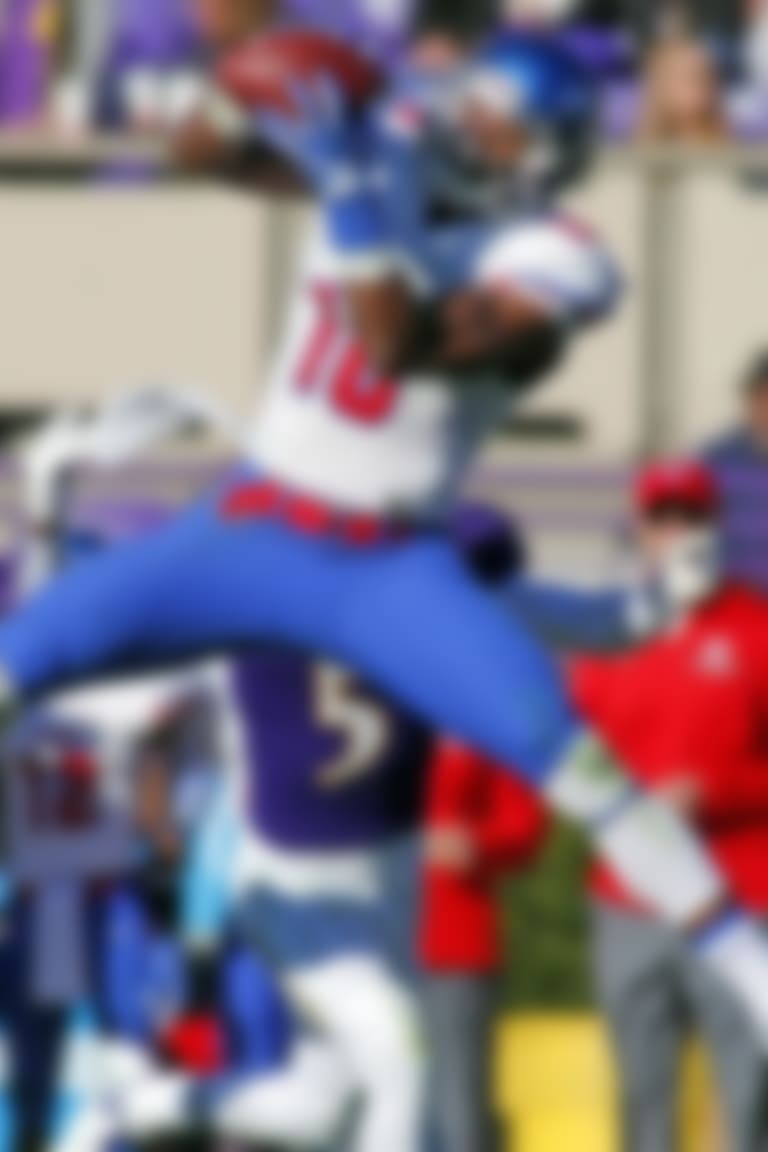Molded by arduous work on his family's East Texas farm, the hands of SMU wide receiver Courtland Sutton are now his money-makers ... and the envy of all the land
By Chase Goodbread | Published Jan. 3, 2018
BRENHAM, Texas – In a few weeks, an NFL scout will stretch a measuring tape across Courtland Sutton's hands at the scouting combine to assess the wide receiver's most valuable asset. It'll be done in about two seconds.
The measurement will be taken from the tip of the thumb, across the palm, to the tip of the pinky finger, and from that point on, Sutton's hands will become just a number. It will get lost amid hand measurements for more than 300 other draft prospects, all recorded with the same rapid-fire brevity, and booked into record by all 32 NFL clubs.
From that number, they'll know exactly how much pigskin will fit into the hands of the Southern Methodist wideout.
But they'll know absolutely nothing about what else Sutton's hands can do.
Sutton's hometown of Brenham, located just south of College Station, halfway between Austin and Houston, is known as the baseball capital of the state. Former Milwaukee Brewers slugger Cecil Cooper is from here, and the Brenham High Cubs have proudly notched seven state titles.
The Blue Bell creamery serves as the economic heartbeat for the town's 17,000 residents, and Sutton played football just down the street from the massive ice cream factory, which also sponsors the school's athletics.
There is plenty of farming in the area, too.
And long before Sutton became a three-sport athlete for the Cubs, he was introduced to farm work by his father, Ryian Marshall.
On the outskirts of Brenham, near the Brazos River, the Marshall farm has been in the family for generations, and Sutton spent his share of weekends there as a kid. Located in an area called Old Washington, the ranch includes 60 head of cattle, some hogs, and an endless list of chores. When he was younger, it was more of a place to goof around with cousins and have fun, but as Sutton got older, he built his work ethic with some of the most physically demanding tasks on the property.
"I'd give him post-hole diggers and have him go three feet deep, into hard ground. It was hard enough work that anything else he came across was going to be a piece of cake compared to it," said Marshall, a lineman for the electric company. "My father did the same for me, and I turned out alright. I didn't go to school and get an education, but I could work with my hands. The good Lord makes doctors, lawyers, and us laborers, too. And that's OK. But I'm glad Courtland went to school and got a degree. Now he's got both."
Fence-mending. Cattle-feeding. Building water gaps. T-post-driving. Young Courtland learned a variety of skills, and none of them were much fun.
He's warred with the dreaded mesquite bush, a Texas farming nuisance with no real useful purpose and a reputation for absorbing too much water for surrounding plants to survive. Also known as a Devil Tree, it features nasty thorns that can grow to three inches, and Sutton knows what it feels like to be stuck by one.
"My grandfather tried everything to get rid of them," Sutton said. "We'd cut them down, we'd get the tractor and mow them down, and then they just grow back stronger."
When the farm chores were done, and not a minute sooner, Sutton would turn to his favorite hobby: fishing. Right on the farm, he could hook bass, crappie and perch, but the bass were his favorite. His father taught him to cast a line, and he could reel them in for hours on end, either with his family, or with his best childhood friend, Jacob Deramus, who now runs cross-country at Stephen F. Austin.
Asked if he's been city-fied by four years in Dallas, Sutton calls himself "still 75-percent country boy."
When he first arrived at SMU, however, he quickly learned fishing wouldn't come easily. He'd open maps of the Dallas area, look for anything blue, and drive there with his pole – only to find the water was on a private golf course where fishing wasn't permitted.
Then, he and Myron Gailliard, a fellow fishing enthusiast and Mustangs wide receiver, stumbled into a honey hole.
"We found a secret place that doesn't even show up on a map. There are huge fish there, and they bite hard. And we don't tell anyone where it is," Sutton said. "It's in the Dallas area. I'll just say that."
Sutton clammed up on the topic from there, like any self-respecting fisherman. It doesn't matter that his NFL destination – unless it's his childhood favorite Dallas Cowboys – will force him to explore new spots of blue on an entirely different map. What matters is that, whenever he makes his way back to his secret Dallas fishing hole, it's remained untouched since his last visit.
Asked about his biggest catch ever, he holds his hands about a foot and a half apart, then separates them a little farther.
"I'm not into weighing them. Maybe 8, 9 pounds?" he responds. "Fishermen never tell the exact truth on that."
If truth be told, Sutton wasn't the highly sought-after recruit one would expect of an eventual elite NFL draft prospect. In 2013, Texas and Texas A&M passed on the three-star prospect. He took an official weekend visit to Colorado, only to be told the team was out of scholarships.
"When he took his official visit to Colorado, at that time, your parents had to pay your way," said Brenham High coach Glen West. "They flew back in from Denver for the team banquet that Sunday night, and I remember how disappointed they were."
How Sutton slipped through the recruiting cracks is a complicated tale. For one thing, he was a late bloomer physically. He's grown three full inches since arriving at SMU, and back in his junior year of high school, when most firm scholarship offers are distributed, he was about 6 feet and 190 pounds.
Not only that, but he was a 6-foot, 190-pound tight end. Brenham was loaded at the receiver position, and Sutton's role was as an undersized, hand-on-the-ground tight end whose primary job it was to block. And 190-pound blocking tight ends don't stand out to college recruiters on film, no matter how well they block.
"I used to have to watch film with the O-line," Sutton said with a laugh. "I knew that wasn't where I was supposed to be, but it's what the team needed."
Just a year earlier, he had caught 22 TD passes for the JV team. A year later, as a senior, he was a prolific receiver for a Brenham squad that reached the state championship game. But by then, scholarships had long been offered to and claimed by others.
As a three-sport athlete – football, basketball and baseball – he didn't have time to attend many camps. And when college coaches came to Brenham to evaluate prospects for spring practice, Sutton was often on the baseball field.
His one option was BYU, and it didn't appeal much.
The week before signing day, SMU came to Brenham in a scramble. One of its commitments had backed out, and the Mustangs were looking to fill the spot.
"BYU was going to be a bit much on momma, losing her baby that far away," said Courtland's mother, Phelicia Marshall. "SMU was a prayer answered. It was, 'Send us a good school, a close school, here in Texas.' SMU came the week before signing day and we went up for a visit that weekend."
SMU's coach at the time, June Jones, started Sutton off at safety, a position Sutton also played in high school. A back injury in his third game forced him to take a redshirt year. The following spring, Chad Morris, who had coached the likes of DeAndre Hopkins and Sammy Watkins as Clemson's offensive coordinator, took over the program and saw a much different future for Sutton.
"(Morris) texted me one night and said, 'Gosh, I'm in love with Courtland Sutton. What's he doing here?' " said West. "Chad's offenses always feed their best receiver, so that was a perfect storm. I don't know if his career would've taken off like it did if it weren't for Chad Morris. He started featuring him right off the bat."
In the four years he was at SMU, the Mustangs won 1, 2, 5 and 7 games. A huge part of the program's resurgence under Morris, Sutton left SMU as a three-time team captain who amassed the third-most receiving yards (3,152) and second-most touchdowns (31) in school history.
The redshirt junior declared early for the draft after the Mustang's 51-10 loss to Louisiana Tech in the Frisco Bowl. With a degree in sports management in his back pocket, there wasn't much left for him to prove. The NFL beckoned.














